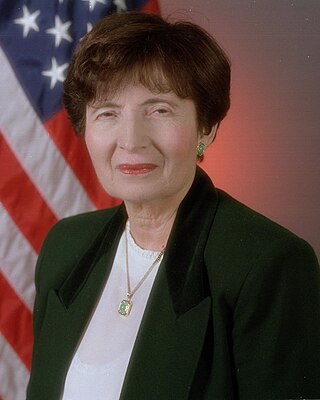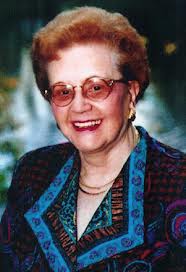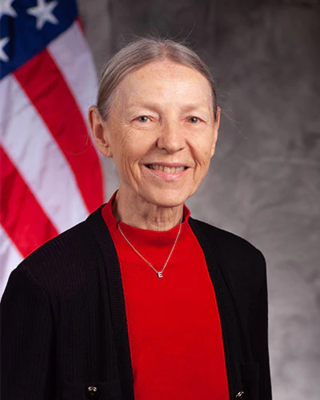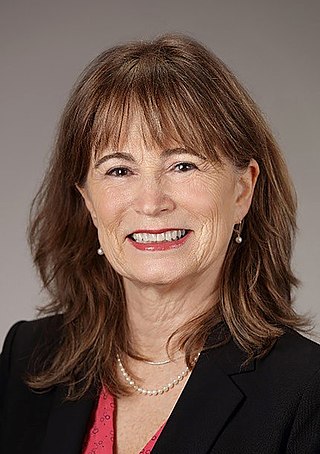Related Research Articles

Hildegard E. Peplau was an American nurse and the first published nursing theorist since Florence Nightingale. She created the middle-range nursing theory of interpersonal relations, which helped to revolutionize the scholarly work of nurses. As a primary contributor to mental health law reform, she led the way towards humane treatment of patients with behavior and personality disorders.
Nursing theory is defined as "a creative and conscientious structuring of ideas that project a tentative, purposeful, and systematic view of phenomena". Through systematic inquiry, whether in nursing research or practice, nurses are able to develop knowledge relevant to improving the care of patients. Theory refers to "a coherent group of general propositions used as principles of explanation".
The American Academy of Nursing (AAN) is a professional organization that generates, synthesizes, and disseminates nursing knowledge to contribute to health policy and practice for the benefit of the public and the nursing profession. Founded in 1973, the organization is an independent affiliate of the American Nurses Association (ANA). The organization publishes a bimonthly journal known as Nursing Outlook.

Faye Glenn Abdellah was an American pioneer in nursing research. Abdellah was the first nurse and woman to serve as the Deputy Surgeon General of the United States. Preceding her appointment, she served in active duty during the Korean War, where she earned a distinguished ranking equivalent to a Navy Rear Admiral, making her the highest-ranked woman and nurse in the Federal Nursing Services at the time. In addition to these achievements, Abdellah led the formation of the National Institute of Nursing Research at the NIH, and was the founder and first dean of the Graduate School of Nursing at the Uniformed Services University of the Health Sciences (USUHS). A few of Abdellah's more passionate interests in public health included the importance of long-term care planning for elderly patients; the need to strengthen nursing school infrastructure; and the necessity of patient-centered approaches in nursing. In 2000, Abdellah was inducted into the National Women's Hall of Fame. During her acceptance speech, Abdellah made the following quote: "We cannot wait for the world to change. .. Those of us with intelligence, purpose, and vision must take the lead and change the world. .. I promise never to rest until my work has been completed!”

Madeleine Leininger was a nursing theorist, nursing professor and developer of the concept of transcultural nursing. First published in 1961, her contributions to nursing theory involve the discussion of what it is to care.

Dorothea Elizabeth Orem, born in Baltimore, Maryland, was a nursing theorist and creator of the self-care deficit nursing theory, also known as the Orem model of nursing.
The New York University Rory Meyers College of Nursing offers undergraduate and graduate programs in nursing and clinical experience.
Jean Watson, PhD, RN, AHN-BC, FAAN, LL (AAN) is an American nurse theorist and nursing professor who is best known for her theory of human caring. She is the author of numerous texts, including Nursing: The Philosophy and Science of Caring. Watson's research on caring has been incorporated into education and patient care at hundreds of nursing schools and healthcare facilities across the world.
Martha Elizabeth Rogers was an American nurse, researcher, theorist, and author. While professor of nursing at New York University, Rogers developed the "Science of Unitary Human Beings", a body of ideas that she described in her book An Introduction to the Theoretical Basis of Nursing.
Imogene King was a pioneer of nursing theory development. Her interacting systems theory of nursing and her theory of goal attainment have been included in every major nursing theory text. These theories are taught to thousands of nursing students, form the basis of nursing education programs, and are implemented in a variety of service settings.
Sister Callista Roy, CSJ is an American nun, nursing theorist, professor and author. She is known for creating the adaptation model of nursing. She was a nursing professor at Boston College before retiring in 2017. Roy was designated as a 2007 Living Legend by the American Academy of Nursing.

Vernice Doris Ferguson was an American nurse and healthcare executive. She was the nursing department head at the National Institutes of Health Clinical Center for several years, then served as a nurse executive with the United States Department of Veterans Affairs for twelve years. Ferguson held faculty appointments at several American universities. She was named a Living Legend of the American Academy of Nursing, was the second American named an honorary Fellow of the Royal College of Nursing in the United Kingdom and received several honorary doctorates.
Patricia Sawyer Benner is a nursing theorist, academic and author. She is known for one of her books, From Novice to Expert: Excellence and Power in Clinical Nursing Practice (1984). Benner described the stages of learning and skill acquisition across the careers of nurses, applying the Dreyfus model of skill acquisition to nursing practice. Benner is a professor emerita at the University of California, San Francisco UCSF School of Nursing.
Phyllis Noerager Stern was an American registered nurse, college professor and nursing theorist. Stern was known for her contributions to international women's health and for developing Glaserian grounded theory approaches used in nursing research. She held faculty appointments at several schools, including Dalhousie University and Indiana University. She was designated a Living Legend of the American Academy of Nursing in 2008.
Nola J. Pender is a nursing theorist, author, and academic. She is a professor emerita of nursing at the University of Michigan. She created the Health Promotion Model. She has been designated a Living Legend of the American Academy of Nursing.
Jessie May Scott was an American nurse and healthcare administrator. She served as Assistant Surgeon General and directed the nursing division of the United States Public Health Service (PHS). Scott advocated for nursing education at the federal level and she received several awards from national organizations honoring her contributions to nursing.

Alison Joan Tierney FRCN is a British nursing theorist, nurse researcher and former editor-in-chief of the Journal of Advanced Nursing. Tierney was one of the first graduates (1971) of the Integrated Degree/Nursing programme at The University of Edinburgh. In 2018 she was named as one of 70 of the most influential nurses in the 70 years of the NHS.
Winifred W. Logan is a British Nurse theorist who was co-author of the Roper-Logan-Tierney model of nursing, and became an executive director of the International Council of Nurses, and Chief Nurse in Abu Dhabi.

Elaine Lucille Larson is an American infectious disease specialist. As a Professor of Epidemiology at the Columbia University Mailman School of Public Health, she has published four books and more than four hundred articles on the subjects of infection prevention and control, disease epidemiology, and related issues. In 2017, Larson was named a "Living Legend" by the American Academy of Nursing, the Academy's highest honor.

Ann King Cashion is an American nurse scientist specialized in genetic markers that predict clinical outcomes. She is a professor emerita in the department of health promotion/disease prevention at the University of Tennessee Health Science Center. Cashion was the acting director of the National Institute of Nursing Research from 2018 to 2019.
References
- 1 2 3 Alligood, Martha Raile (December 27, 2013). Nursing Theorists and Their Work. Elsevier Health Sciences. pp. 442–443. ISBN 978-0-323-29291-7 . Retrieved December 20, 2014.
- 1 2 Endo, Emiko (2017). "Margaret Newman's Theory of Health as Expanding Consciousness and a Nursing Intervention from a Unitary Perspective". Asia-Pacific Journal of Oncology Nursing. 4 (1): 50–52. doi: 10.4103/2347-5625.199076 . ISSN 2347-5625. PMC 5297232 . PMID 28217730.
- ↑ Sitzman, Kathleen; Eichelberger, Lisa Wright (August 15, 2010). Understanding the Work of Nurse Theorists: A Creative Beginning. Jones & Bartlett Learning. p. 187. ISBN 978-1-4496-1127-9.
- ↑ "Margaret A. Newman: Nurse Theorist". University of Tennessee Health Science Center . Retrieved December 20, 2014.
- 1 2 "Margaret Newman, early nurse theorist and faculty emeritus, dies". School of Nursing - University of Minnesota. 3 January 2019. Retrieved May 19, 2020.
- ↑ Pharris, Margaret Dexheimer (July 2011). "Margaret A. Newman's Theory of Health as Expanding Consciousness". Nursing Science Quarterly . 24 (3): 193–194. doi: 10.1177/0894318411409437 . ISSN 0894-3184. PMID 21742705. S2CID 206571850.
- ↑ "Academy Living Legends". American Academy of Nursing . Retrieved December 20, 2014.